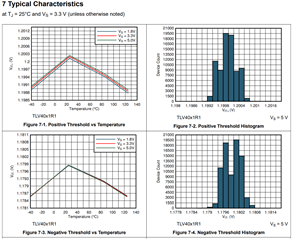Hi
We're about to use TLV4021R1YKAR in one of our new designs.
I'm struggling to interpret the precision of the device in terms of positive- and negative-going input threshold.
In the datasheet chapter 6.5 the positive-going input threshold is 1.188V to 1.212 V over the full temperature range for Vs = 1.8 V.

However, in the typical characteristics in chapter 7 we find the following graphs. The top left graph shows that the positive-going threshold in function of the temperature and also for different supply voltage is very precise and does not exceed 1.1988 to 1.2003 V in any case. Also the top right graph shows, that the threshold is very precise around 1.2V with a big number of tested devices.

What's the tolerance of the positive-going threshold? What's the difference of the table in 6.5 and the figures in chapter 7? Why do the values differ? Same questions apply to the negative-going threshold.
Thanks and best regards,
Martin

